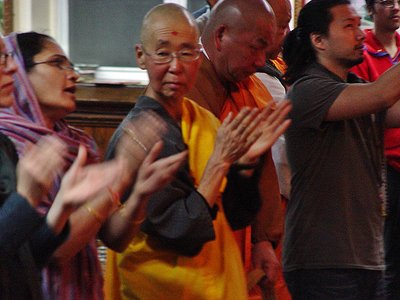The soft, heartbeat-like sound of a small drum could be heard keeping time as a group of around 20 “No More Fukushimas” peace walkers, lead by 64-year-old Japanese Buddhist nun Jun Yasuda, approached Weehawken’s Swaminarayan Temple Wednesday evening.
That day, they had walked nearly 20 miles from Staten Island, across the Bayonne Bridge, through Jersey City and Hoboken, and were welcomed by the Hindu temple as visiting pilgrims and fed a vegan meal prepared by temple members.
On March 11, 2011, an earthquake caused a tsunami in Japan, which threw the Fukushima Nuclear Power Plant into serious crisis. The resulting radiation pollution has reached levels higher than the Chernobyl disaster in the Ukraine, according to anti-nuclear expert and activist Dominique French, who addressed the peace walkers that evening.
The walkers come from far and wide: some lived near Fukushima in Japan, some are from Hudson County, and some join along the route.
The walkers began their silent protest on March 2 at Oyster Creek Nuclear Power Plant in Forked River, N.J., which has a similar design to the devastated Fukushima plant. The walk will culminate at the Vermont Yankee Nuclear Power Plant in that state after a 250-mile journey on foot.
“There are 120 million Americans who live within 50 miles of nuclear reactors,” French said.
For example, Indian Point Energy Center in Buchanan, N.Y., (a destination on the peace walkers’ journey) is 38 miles from New York City, placing Hudson County within that 50-mile radius.
From Japan to Weehawken
Peace walker and Queens resident Christian Collins began walking on March 2. He walks to lend “spiritual support to the cause to try to imagine a world beyond nuclear energy,” he said.
The group of walkers grows and diminishes depending on the location, with a core of about 15 who travel the entire 250 miles, Collins added. They hold peaceful vigils in protest at nuclear power plants and specific related government sites along the way, and they rest each evening at various temples, churches, and homes of those who volunteer the space.
Weehawkenite Hemal Trivedi met Yasuda last year when Trivedi filmed a documentary highlighting the Buddhist nun’s cause. “I was looking for Buddhist faith in action, and I found it in Jun Yasuda,” she said last week.
This year, Yasuda asked Trivedi if she knew of anyone local who would be willing to put her and her peace walkers up for the night. Trivedi arranged the evening of prayer and presentation with the temple and offered her own home so they could rest up for the following day’s 20 mile journey.
Yasuda has been leading peace walks to protest nuclear energy for 30 years. She is a Buddhist nun of the Nipponzan Myohoji order, and travels here because of the similarities she sees between the nuclear plants in Japan and those in the states.
“Because of Jun’s efforts,” Trivedi said, “now people of all nationalities and religion join the peace walkers in solidarity to protect the resources of mother Earth.”
“Now people of all nationalities and religion join the peace walkers in solidarity.” –Hemal Trivedi
_____________
Lessons learned from Fukushima
After a group chant in reverence to the cause, Yasuda spoke to those who had gathered at the temple. She spoke of Fukushima, and how the efforts to clean up after the disaster continue.
“My country has 54 nuclear power plants, and here there are 100,” she said, “and they’re all over 30 years old. Earthquakes do not only happen in Japan.”
French spoke of a Nuclear Energy Institute press conference she attended, where they discussed the “lessons learned” from Fukushima. “It really struck a chord with me,” she said, “because I don’t think any of these [local] plants are interested in applying these lessons.”
French told the group that both the Oyster Creek and Vermont Yankee plants have the same reactor containment as Fukushima, which clearly failed to do its job. She said that the plants simply need to be shut down.
“Indian Point is so close to so many people,” French said, “there’s no way they could be evacuated in time.”
French has petitioned the Nuclear Regulatory Commission to expand what are known as “emergency planning zones” surrounding the plants, or areas of evacuation in case of a nuclear emergency. They currently run in a 10-mile radius around the reactors for human beings, and a 50 mile radius for food and water safety.
However, she said, Chernobyl and Fukushima’s negative radiation effects extended at least 25 miles. She believes the zones should be expanded to 50 and 100 miles, respectively.
“Nuclear disaster not only affects humans,” Yasuda said, “but all living things. We must join together and use our human spiritual power to prevent this from happening again.”
For more information on the group’s efforts, visit nomorefukushimaswalk.tumblr.com.
To comment on this story on-line, go to our website, www.hudsonreporter.com, and comment below. Gennarose Pope may be reached at gpope@hudsonreporter.com.
